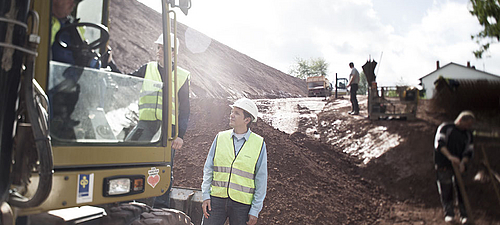What is microplastic?
There is currently no official and globally recognised definition for microplastics. The different meanings differ slightly. In our view, plastic particles with a size of less than 5 mm are microplastics.
We differentiate between primary and secondary microplastics on the basis of their origin. Primary microplastic type A is already smaller than 5 mm during the production phase. Primary microplastic type B is created during the use of larger plastic parts. A prominent example of this is tyre abrasion. Secondary microplastics result from fragmentation or weathering of macroplastics in the environment, e.g. uncontrolled waste disposal. The term littering is often used for this.

The ten biggest polluters in Germany
Study by the Fraunhofer Institute determines the emitters of microplastics.
According to this study from 2018, a total of around 4 kg of primary microplastics per person, per year are released into the environment in Germany. Type B dominates with a share of 89%. By far the largest cause is tyre abrasion, especially from cars, with a total of 1,082 g/head/year. In position six, we have distribution via construction sites. By far the largest share of this group is abrasion from demolition work at 90 g/head/year, followed by the processing of plastics on construction sites (25.4 g/head/year). Geotextiles are not explicitly named. The group "Abrasion of plastics used in agriculture" is in 12th place and no longer in the top 10. A further subdivision of this group cannot be found in the study.
Yearly quantities released per person

(of which 88% from cars)

in asphalt


waste disposal

and playgrounds

construction sites

from shoes

plastic packaging

road markings

during textile washing
| To the study: www.umsicht.fraunhofer.de | Source: Frauenhofer UMSICHT 2018, own representation |

Technical textiles account for approximately 0.6% of annual plastics production
When assessing the emitters of microplastics, it is also helpful to look at the production quantities of plastic. Approximately 360 million tonnes of plastic are produced worldwide each year. The share of technical textiles made of synthetic filament fibres is 34.5 million tonnes or 9.6%. The share of this processed in the construction industry is much lower at 1.4%. This includes a large proportion of textiles used in building construction (75% of the 1.4%). According to our own estimates, we assume that the share in the geosynthetics and agriculture sectors is a maximum of 0.57% or around 2 million tonnes. This includes the large market for simple gardening and landscaping textiles. Technically sophisticated textiles such as those offered by HUESKER are, in our opinion, less than 1 million tonnes (0.28%). However, we have no neutral and reliable statistics on this.
High safety through technical textiles
We make our contribution to improving environmental sustainability.
The risk of micro-plastic emissions from our technical textiles is very low and easily controlled, as our products are explicitly designed for a long service life. Microplastics can only be caused by mechanical, chemical or photochemical stress in the following four steps of the product life cycle and can be reduced to a minimum if used correctly.




HUESKER Microplastics Management
Here we explain the environmental performance of technical textiles in comparison to conventional construction methods. Beyond the product advantages, we are constantly working on optimising our processes to achieve further ecological effects. Even though the microplastic emissions of our products are extremely low, we strive to reduce them even further to an absolute minimum. Find out what specific measures HUESKER is taking to improve environmental protection.
- Efficient use of materials
- Recycling of waste
- Avoidance of plastic packaging
- Optimal choice of materials
- Use of local resources
- Reduction steel & concrete
- Installation Recommendations
- Avoidance of protruding remains
- Disposal of packaging & waste
- Advice for the builders / designers
- Exchange of textiles
- Research for prevention
- Taking back removed products
- Supply of thermal recycling
- Recycling
- High quality, durable products
- Recycled yarn
- Biodegradable raw materials







